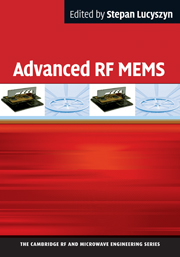Book contents
- Frontmatter
- Dedication
- Contents
- List of Contributors
- Preface
- List of Abbreviations
- 1 Introduction
- 2 Electromechanical modelling of electrostatic actuators
- 3 Switches and their fabrication technologies
- 4 Niche switch technologies
- 5 Reliability
- 6 Dielectric charging
- 7 Stress and thermal characterisation
- 8 High-power handling
- 9 Packaging
- 10 Impedance tuners and tuneable filters
- 11 Phase shifters and tuneable delay lines
- 12 Reconfigurable architectures
- 13 Industry roadmap for RF MEMS
- Author biographies
- Index
- References
3 - Switches and their fabrication technologies
Published online by Cambridge University Press: 05 February 2014
- Frontmatter
- Dedication
- Contents
- List of Contributors
- Preface
- List of Abbreviations
- 1 Introduction
- 2 Electromechanical modelling of electrostatic actuators
- 3 Switches and their fabrication technologies
- 4 Niche switch technologies
- 5 Reliability
- 6 Dielectric charging
- 7 Stress and thermal characterisation
- 8 High-power handling
- 9 Packaging
- 10 Impedance tuners and tuneable filters
- 11 Phase shifters and tuneable delay lines
- 12 Reconfigurable architectures
- 13 Industry roadmap for RF MEMS
- Author biographies
- Index
- References
Summary
Introduction
Over the past ten years, a large number of RF MEMS switches have been developed by use of various fabrication technologies. When compared with bulk acoustic wave (BAW) filters, which are fabricated in millions of units and by tens of companies, the commercialisation of RF MEMS switches and varactors is just beginning. First, it is a very complex challenge, from a technological point of view. Like inertial sensors, RF MEMS switches are based on fragile movable microstructures. Instead of polysilicon, highly conductive metals (e.g. gold (Au), aluminium (Al) and copper (Cu)) must be used and these result in a decrease in thermal stability. Therefore, common MEMS packaging techniques performed at 400 to 500 °C cannot be applied. Also, RF MEMS switches must be packaged hermetically for them to be protected from environmental influences. In addition, device reliability is still problematic, mainly because surfaces come into contact for billions of switching cycles. Under these circumstances, it is easy to imagine that a successful development presupposes quite significant scientific, engineering and financial resources. Second, the numerous conflicts between the following are easily underestimated: concept and operation, RF design and signal routing and fabrication and packaging.
The choice of switch principle, as well as appropriate fabrication technology, strongly depends on the particular intended application. Several application areas for RF MEMS switches are named in the report of Wicht Technologie Consulting (WTC) [1]. For ATE applications, ohmic (i.e. metal contact) RF MEMS switches are chosen from the outset because of their excellent performance over a frequency that can range from dc to many tens of gigahertz. The possibility of a direct replacement of solid-state switches by RF MEMS devices is another important advantage. It can be expected that ohmic switches will dominate in telecommunications switching matrices because of their low frequencies of operation. Phased-array antennas, probably the main application for aerospace and defence, could be based on both ohmic and capacitive switches. In total, it is predicted that this area of the market could be worth more than $150 million in 2011. These products are high-end systems with moderate cost sensitivity. The crucial factor here is the performance improvement.
- Type
- Chapter
- Information
- Advanced RF MEMS , pp. 41 - 72Publisher: Cambridge University PressPrint publication year: 2010



